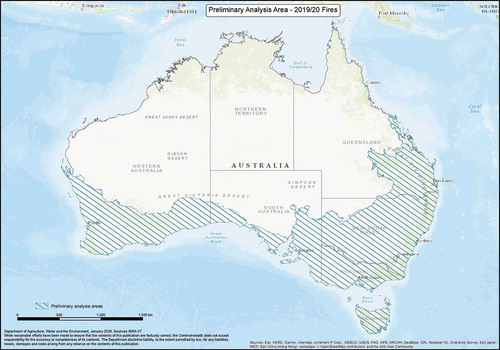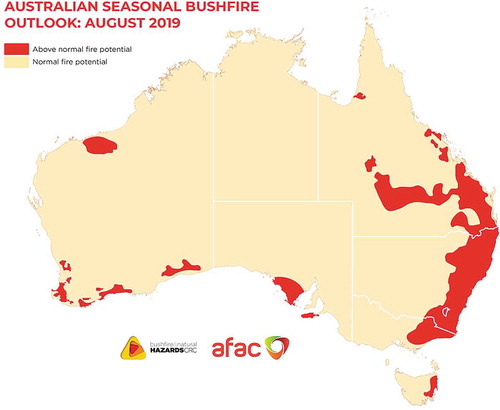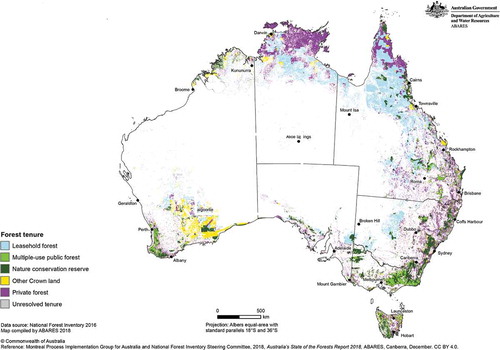In their review of prescribed burning in south-eastern Australia, Morgan et al. (Citation2020) stated that, ‘[t]he increasing extent and occurrence of wildfire disasters in south-eastern Australia indicates that current fire management will not sustain the full range of ecosystem processes and biodiversity, nor reduce to an acceptable level the impact of wildfires on human lives and property’ (p. 4 and p. 21). Morgan et al. (Citation2020) provided data on major Australian wildfires (bushfires) in southern Australia to the end of the 2018/19 fire season. As the paper was being finalised in the 2019/20 fire season, major fires were burning across eastern and southern Australia. That season is now commonly referred to as ‘Black Summer’Footnote1 and has also been called ‘the summer from hell’, ‘black Christmas’ and ‘black New Year’. This editorial provides information on the Black Summer bushfires, which occurred during the eight-month period to the end of February 2020; it forms a postscript to the paper by Morgan et al. (Citation2020).
The term ‘unprecedented’ was used in commentary applied to the Black Summer bushfires.Footnote2 Hansen (Citation2018) reviews the use of this term as a descriptor in the context of Australian bushfires in previous fire seasons. Historical fires reported in Morgan et al. (Citation2020) were confined to one or two states (or territories) in a season; the largest was the 1951/52 fire in New South Wales, which burnt 5.47 million ha. In contrast, the Black Summer bushfires comprised major fires across multiple states and territories, burning nearly double the area of any previous major bushfires in a fire season reported by Morgan et al. (Citation2020). Again, New South Wales recorded the highest burnt area, at 5.68 million ha, followed by Western Australia (2.04 million ha) and Victoria (1.58 million ha). The mapped extent of these fires across multiple states and territories totalled 10.2 million ha (). shows the preliminary area for an environmental analysis of impacts of the Black Summer bushfires on biodiversity and heritage values being carried out by the federal Department of Agriculture, Water and the Environment; this area was also used in the provision of data presented in and .
Table 1. Impacts of and area burnt in Australia’s 2019/20 fire season, as of March 2020, by state and territory
Table 2. Total area of Australia’s native forests and the area and proportion burnt in southern and eastern Australia in the 2019/20 fire season, as of 23 March 2020, by forest tenure and jurisdiction
Figure 1. Preliminary area of environmental analysis of the 2019/20 bushfires (source and credit: Department of Agriculture, Water and the Environment Citation2020).

The memory of the Black Summer bushfires is etched in the minds of most Australians. The fires had major impacts on many rural communities, causing property, farm, livestock and wildlife losses and affecting local tourism and economies; these impacts also resonated across the nation and internationally. The Black Summer bushfires affected town and city water catchments. Smoke from the fires blanketed many Australian cities for weeks, causing harmful levels of air pollution that far exceeded national air-quality standards (Arriagada et al. Citation2020). Ash and smoke from the fires was reported in New Zealand during January 2020,Footnote3 and smoke was reported near South America in January 2020 (Putman Citation2020). Bushfire inquiries have commenced in New South Wales, South Australia and Victoria, with a Senate inquiryFootnote4 and a national royal commission.Footnote1 also established.
Thirty-three deaths occurred as a result of these fires, 25 of them in New South Wales. Nine firefighting personnel died, comprising three American aircrew and three Rural Fire Service volunteer firefighters in New South Wales and three members of Forest Fire Management Victoria. Fires destroyed 3100 homes nationwide, with 79% of the losses occurring in New South Wales, 13% in Victoria, 6% in South Australia and 2% in Queensland; there were also losses in Western Australia and Tasmania ().
A total of 8.19 million ha of native forest was burnt. This was 81% of the total burnt area, with the other 19% comprising agricultural croplands and grasslands, forest plantations, other forest, peri-urban lands, and native grasslands, heath and shrublands. Australian biodiversity and ecological communities were severely affected, particularly those in native forests. A total of 8.34 million ha of forest (i.e. native + planted) was burnt; in addition to the native forest, this included 129 000 ha of commercial plantations and 22 000 ha of other forest ().Footnote5 Thirteen percent of native forests, 7% of commercial plantations and 5% of other forest found in the preliminary analysis area in southern and eastern Australia was burnt (C. Howell, ABARES, pers. comm., February 2020). Of the commercial plantations burnt, 92 000 ha was in New South Wales, 17 000 ha in South Australia, 10 000 ha in Victoria and 4000 ha in Western Australia; 3000 ha was burnt in each of Queensland and Tasmania.
Southern and eastern Australia were subject to an extended period of drought in 2018 and 2019, with much of New South Wales and south-eastern Queensland experiencing a third year of dry conditions in 2019 (Bushfire & Natural Hazards CRC Citation2019). The weather was warmer and drier than average in southern Australia during January to July 2019, which was conducive to raising the fire risk and fire potential. The August 2019 Australian seasonal bushfire outlook (Bushfire & Natural Hazards CRC Citation2019) forewarned that the 2019/20 fire season had the potential to be an active fire season across Australia, with above-normal fire potential predicted in large areas of southern and eastern Australia ()—from Rockhampton in Queensland through eastern New South Wales (including the Australian Capital Territory) to Gippsland in Victoria. Parts of southern Western Australia, South Australia and Tasmania also had above-normal fire potential.
Figure 2. Australian seasonal bushfire outlook August 2019 Notes: Areas are based on the Interim Biogeographic Regionalisation for Australia (IBRA) bioregions and state and territory boundaries (source and credit: Bushfire & Natural Hazards CRC Citation2019).

The 2019/20 fire season started in August 2019, although small fires were reported in July in New South Wales. Major fire events commenced in September and October in New South Wales and Queensland. Dry and windy conditions in October and November raised the fire danger rating to severe across much of eastern Australia. By December, more than 50 fires were burning in southern Queensland and 125 were alight in New South Wales; there were also significant fires in South Australia, Tasmania, Victoria and southern Western Australia. A large fire in the Australian Capital Territory started on 27 January 2020. State-of-emergency declarations were made in the Australian Capital Territory, New South Wales, Queensland and Victoria during the periods of severe and extreme fire danger. Nearly all fires were extinguished by the end of February 2020, with rainfall events occurring across much of southern and eastern Australia.
shows the area of native forest burnt in southern and eastern Australia and its distribution by tenure (note that the forest area in the Northern Territory is included for completeness but is outside the preliminary analysis area in southern and eastern Australia and therefore shows no burnt area). The native forest area statement by tenure is from Australia’s State of Forests Report 2018 (MPIGA & NFISC Citation2018; ). The 8.19 million ha of native forest burnt represents 6% of Australia’s native forests (). Eighty-one percent of the native forest burnt was in public forest.Footnote6 The burnt forest area comprised 3.8 million ha (46%) in nature conservation reserves, 1.9 million ha (23%) in multiple-use public forests, 1.5 million ha (18%) in private forests, 0.9 million ha (11%) on other Crown land and 105 000 ha (1%) in leasehold forest. Nationally, 19% of native forest in multiple-use public forests, and 18% of native forest in nature conservation reserves, was burnt.
Figure 3. Australia’s forests, by tenure (source: MPIGA & NFISC Citation2018 and credit: ABARES. A higher-resolution map is available at www.doi.org/10.25814/5be3bc4321162, fig. 1.4).

Fires burnt 64% of the native forests in the Australian Capital Territory, including 71% of all native forest in nature conservation reserves. In New South Wales, 25% percent of native forests was burnt, including nearly 50% of native forests in both multiple-use public forests and nature conservation reserves; 17% of private native forests was also burnt in that state. In Victoria, 19% of the total native forest area was burnt, including 29% of native forest in multiple-use public forests and 15% of native forest in nature conservation reserves. Although small as a proportion, large areas of native forests in nature conservation reserves and other Crown lands were burnt in Western Australia.
Fire impacts in plantations in New South Wales, South Australia and Victoria will affect regional wood supplies to mills. The large areas of native forest burnt in multiple-use public forests in New South Wales (880 000 ha) and Victoria (878 000 ha) will likely affect regional wood supplies and sustainable yields of forest products.
The Black Summer bushfires provide important insights into, and raise profound questions about, the current and future management of Australian landscapes, particularly forested landscapes. There is tangible evidence of the need to better manage fire risk and the effects of climate change. This will require the implementation of improved planning tools and fire management practices to better: protect local communities, property and infrastructure; manage the reserve system and heritage, biodiversity and water assets; and manage sustainable wood yields in forest landscapes. Prescribed fire will be an important element in managing these risks in the future, and it will be essential to manage fire in forests and other vegetation at the landscape scale across tenures.
The Black Summer bushfires are a watershed for how Australia must manage fire risks in its landscapes and to be better prepared for such fires. The fires of 2019/20 have shown that current fire management will not, or is unlikely to, sustain the full range of ecosystem processes and biodiversity, nor reduce to an acceptable level the impact of wildfires on local and rural communities, forests and ecological communities, biodiversity and wood resources. Finding sustainable, affordable and socially acceptable approaches to managing fire requires a cohesive, considered, evidence-based approach across jurisdictions and tenure.
Acknowledgements
The authors acknowledge the valuable personal communications received from emergency services personnel and government agency personnel with direct experience in reporting and managing the Black Summer bushfires. The forest area analysis presented in and was performed by staff at the Australian Bureau of Agricultural and Resource Economics and Sciences (ABARES) using the National Forest Inventory spatial dataset and Australian Government spatial datasets listed as sources in those tables. Steve Read, Gary Morgan, Claire Howell and Christine Stone provided valuable comments.
Disclosure statement
No potential conflict of interest was reported by the authors.
Notes
1 National royal commission into Black Summer bushfires established. Prime Minister media release 20 February 2020 (https://www.pm.gov.au/media/national-royal-commission-black-summer-bushfires-established). Accessed 4 March 2020.
2 E.g. Australia is not prepared to fight the bushfires of the future, experts warn. ABC Regional and Landline Background Briefing, 7 October 2019, 9:37am (https://www.abc.net.au/news/2019-10-04/the-bushfires-of-the-future-are-here-black-swan/11559930). Accessed 5 January 2020.
3 Media report at https://www.sbs.com.au/news/ash-from-australian-bushfires-turns-new-zealand-glaciers-brown. Accessed 4 March 2020.
4 NSW Independent Bushfire Inquiry (https://www.nsw.gov.au/media-releases/premier-announces-nsw-independent-bushfire-inquiry). Accessed 4 March 2020. Independent review into South Australia’s 2019/20 bushfire season (https://www.premier.sa.gov.au/news/media-releases/news/independent-review-into-south-australias-201920-bushfire-season). Accessed 20 March 2020. Inquiry into the 2019–20 Victorian Fire Season (https://www.igem.vic.gov.au/Fire-Season-Inquiry). Accessed 4 March 2020. Lessons to be learned in relation to the Australian bushfire season 2019–20. Senate Inquiry (https://www.aph.gov.au/Parliamentary_Business/Committees/Senate/Finance_and_Public_Administration/Bushfirerecovery). Accessed 20 March 2020. The following House of Representatives Committee Inquiry was announced on 5 December 2019: ‘Inquiry into the efficacy of past and current vegetation and land management policy, practice and legislation and their effect on the intensity and frequency of bushfires and subsequent risk to property, life and the environment’ (https://www.aph.gov.au/vegetationandlandmanagement). Accessed 26 February 2020. This inquiry was wound up on 26 February 2020 and its material provided to the national royal commission.
5 ‘Commercial plantation’ is a National Forest Inventory forest category and comprises plantations managed for the commercial production of wood. ‘Other forest’ is a National Forest Inventory forest category that includes non-commercial plantations and planted forests, such as farm forestry and agroforestry plantations, sandalwood plantations, environmental plantings, plantations within the reserve system and plantations regarded as not commercially viable. Non-planted forests dominated by introduced species are also included in this category (MPIGA & NFISC Citation2018).
6 Forest on public land for which management responsibility has generally been delegated to government agencies, including multiple-use public forests, nature conservation reserves and other Crown land, but excluding leasehold forest (MPIGA & NFISC Citation2018).
References
- Arriagada NB, Palmer AJ, Bowman DMJS, Morgan GG, Jalaludin BB, Johnston FH. 2020. Unprecedented smoke‐related health burden associated with the 2019–20 bushfires in eastern Australia. Medical Journal of Australia. [accessed 3 Apr 2020]. doi:10.5694/mja2.50545
- Bushfire & Natural Hazards CRC. 2019. Australian seasonal bushfire outlook: August 2019. Melbourne (Australia): Bushfire & Natural Hazards CRC. Hazard Note 63 August 2019. [accessed 2020 Mar 10]. Available from: https://www.bnhcrc.com.au/hazardnotes/63
- Department of Agriculture, Water and the Environment. 2020. Preliminary analysis for environmental analysis – 2019/20 fires. Canberra (Australia): Department of Agriculture, Water and the Environment. [accessed 2020 Mar 10]. Available from: https://www.environment.gov.au/system/files/pages/a8d10ce5-6a49-4fc2-b94d-575d6d11c547/files/preliminary-analysis-area-19-jan-2020.pdf
- Hansen C. 2018. Deep time and disaster: black Saturday and the forgotten past. Environmental Humanities. 10:226–240. doi:10.1215/22011919-4385543
- Morgan GW, Tolhurst KG, Poynter MW, Cooper N, McGuffog T, Ryan R, Wouters MA, Stephens N, Black P, Sheehan D, et al. 2020. Prescribed burning in south-eastern Australia: history and future directions. Australian Forestry. 83:4–28. doi:10.1080/00049158.2020.1739883
- MPIGA & NFISC. 2018. Australia’s State of the Forests Report 2018. Canberra (Australia): Montreal Process Implementation Group for Australia and National Forest Inventory Steering Committee. [accessed 2020 Feb 28]. Available from: https://www.agriculture.gov.au/abares/forestsaustralia/sofr/sofr-2018
- Putman W. 2020. Global transport of Australian bushfire smoke. Greenbelt (MD): NASA Goddard Space Flight Centre. [accessed 2020 Mar 19. Available from: https://gmao.gsfc.nasa.gov/research/science_snapshots/2020/Australia_fires_smoke.php?utm_source=TWITTER&utm_medium=NASA_NCCS&utm_campaign=NASASocial&linkId=80822832
